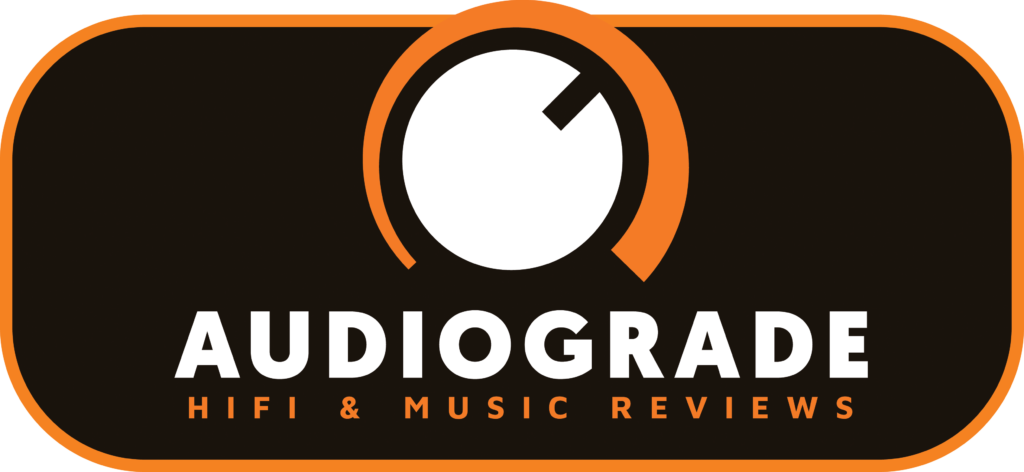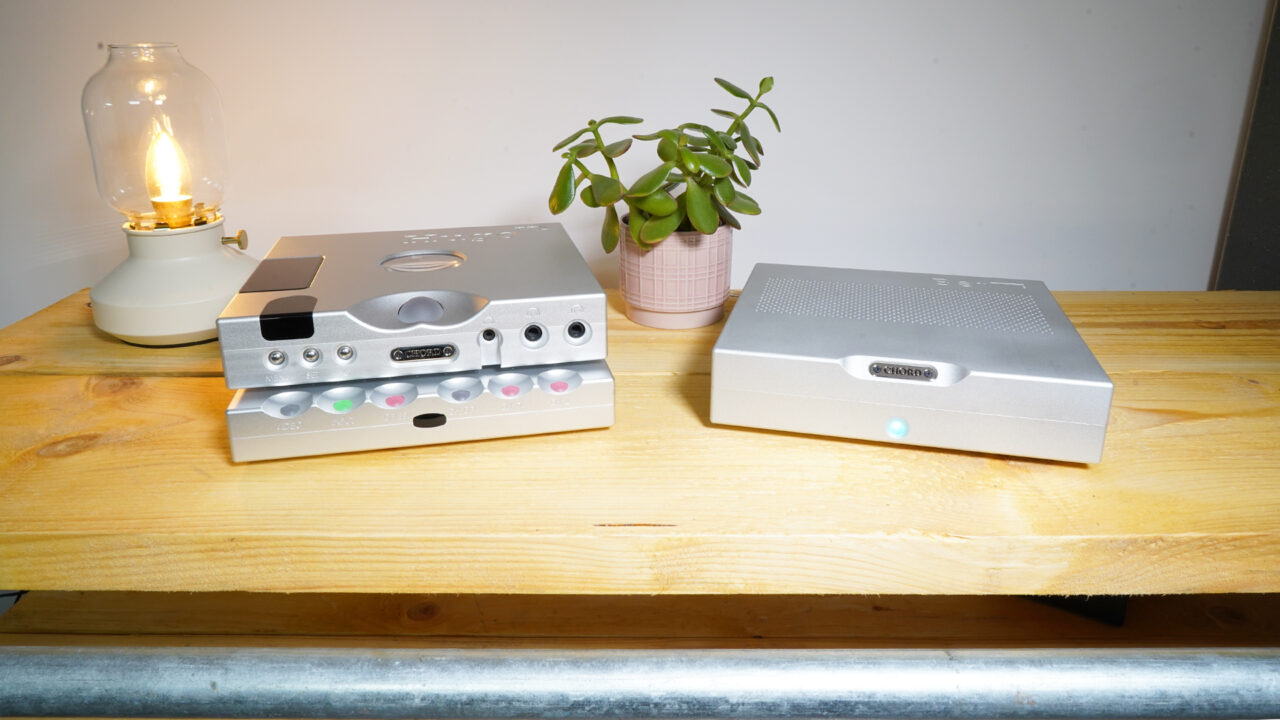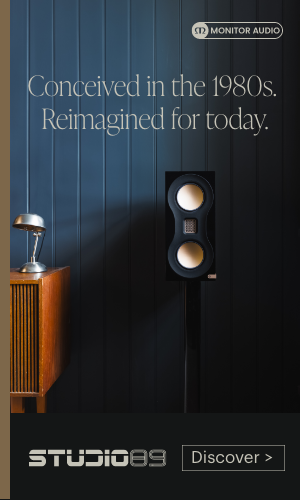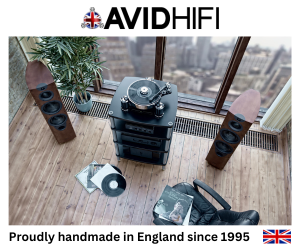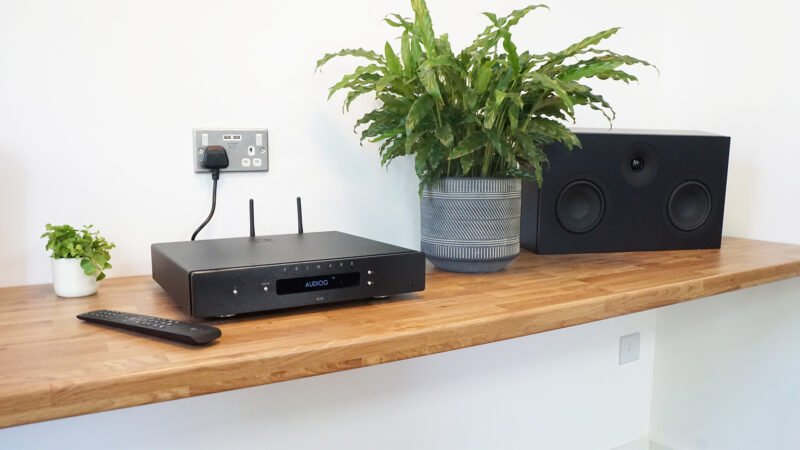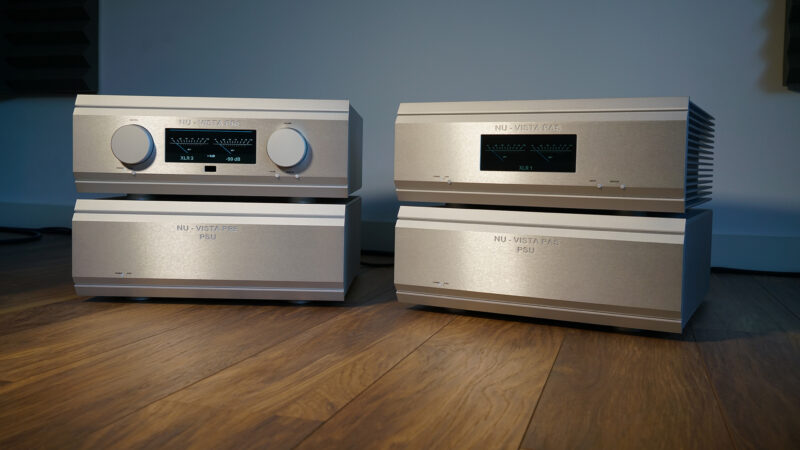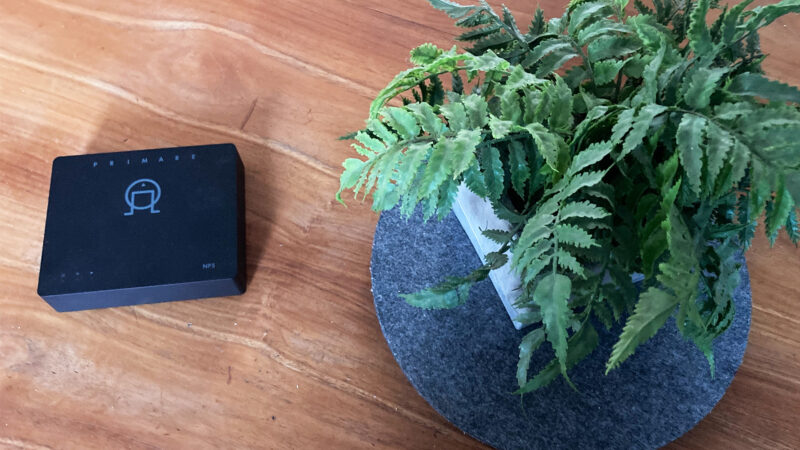While many hifi manufacturers follow the herd, some plough their own furrows.
British born Chord Electronics is very much in the latter camp, by developing its own amplifier and digital tech for decades, resulting in visually striking audio gear that starts with pocket sized performers through to behemothic statements, all of which employ Chord’s carefully crafted internals.
It all started back in 1989 under company Owner and Chief Designer John Franks, who built quite a reputation in supplying amps to the likes of the Beeb, Abbey Road Studios and other global players in the recording industry. With a background in aviation engineering, John’s approach to intelligent switch mode PSUs and his own MOSFET devices became the stuff of hifi legend.
Add to this the digital expertise of Rob Watts (a bloke with a surname clearly destined for hifi) who developed his own FPGAs (Field Programmable Gate Arrays) after being disappointed with the off-the-shelf DAC chips of the day, and you have quite the recipe for an approach to hifi with a difference.
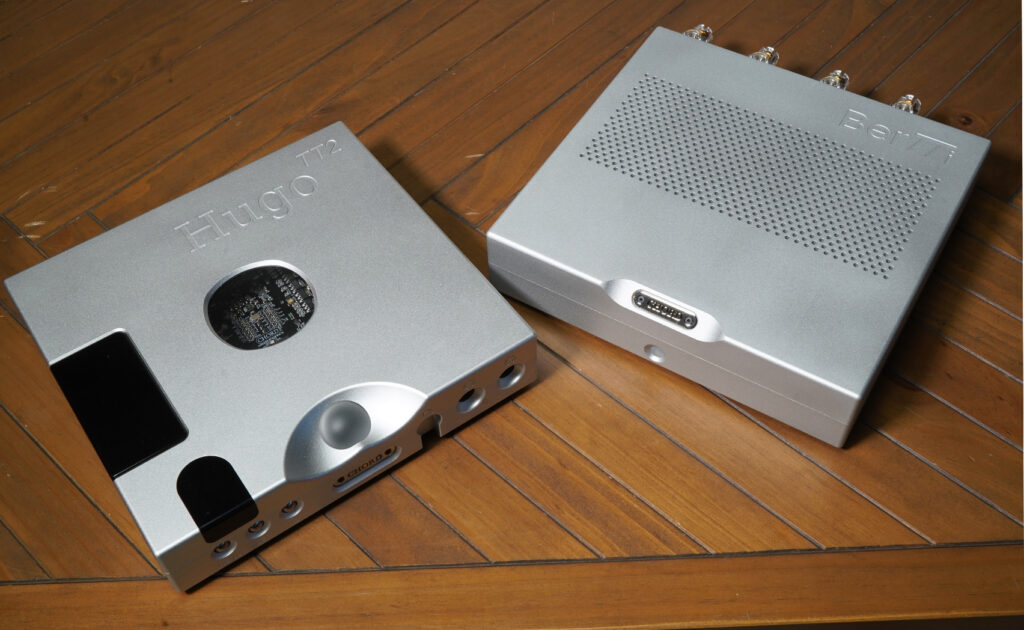
With their demure proportions, Chord’s Table Top range comes in ‘argent’ silver or ‘jett’ black finishes
This has led to groundbreaking digital advancements, including Chord’s WTA (Watts Time Alignment) filter and Pulse Array tech, with up to 600 times the resolving power of alternative DAC chips (both technologies are also closely guarded by military grade encryption to ensure they remain unique to Chord).
Let’s hear it for Hugo
The Hugo models span two ranges, with a five-strong handheld series followed by a trio of table top intended products (denoted by their ‘TT’ monikers), made up of the Hugo TT 2 DAC/preamp, BerTTi power amp (costing £3,995 each) and Hugo M Scaler oversampler (to an industry leading 768kHz LPCM) at £3,495. To get the no holds barred Chord experience, we opted for the TT lot, with a combined price tag of £11,485.
All come in relatively compact cases hewn from solid alloy measuring 234/224mm (wide/high, minus socketry), which, coincidentally, is about the same size as the 24 box of Ferrero Rocher I polished off over Christmas, but I digress…
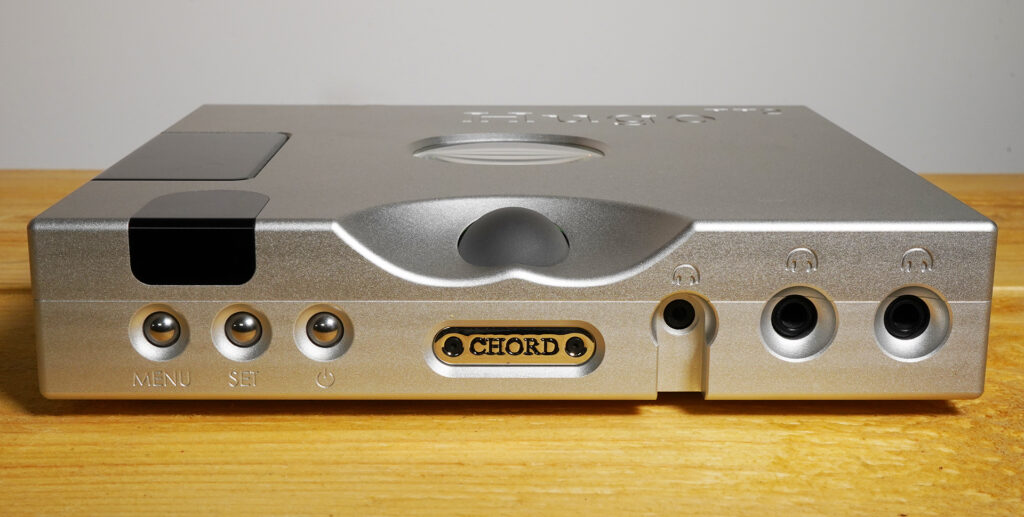
Alongside menu, select and power buttons, the Hugo TT 2’s front panel also hosts a 3.5mm and twin 6.5mm headphone outputs. Central ball volume control glows through a range of colours matched to output level
Starting with the Hugo TT 2 preamp, this builds on both the portable Hugo 2 and original Hugo TT, with twice the processing power of the former (and five times that of the latter). Being both a DAC and preamp, at its heart beats Chord’s own Xilinx Artix 7 FPGA that’s custom-coded by Rob Watts, with 86 x 208MHz cores running in parallel to create an advanced 16FS WTA 1 filter with 98,304-taps.
Its high-power discreet output stage is also new to the TT 2, coupled with second-order noise-shaping integration between the DAC output and filter to reduce distortion. Power delivery has also been thought through by upgrading the Li-Po battery power supply of the original model with six super capacitors, capable of 5A, 9.3V RMS peak output.

Hugo TT 2 rear panel L-R: 15V DC power socket plus BNC, line-level (RCA) and balanced (XLR) outputs, with six inputs spread over twin/single BNC, two optical and one USB-B
Being a DAC and preamp, the Hugo TT 2 can be operated in three main modes, as a dedicated DAC with fixed output, digital only preamp with variable output, or as a dedicated headphone amp, and with each mode comes its own feature set. Ands it’s the DAC where it really excels, supporting PCM up to 32-bit/768kHz (DSD512) over USB and dual BNC, 384kHz over single BNC and 192kHz over optical.
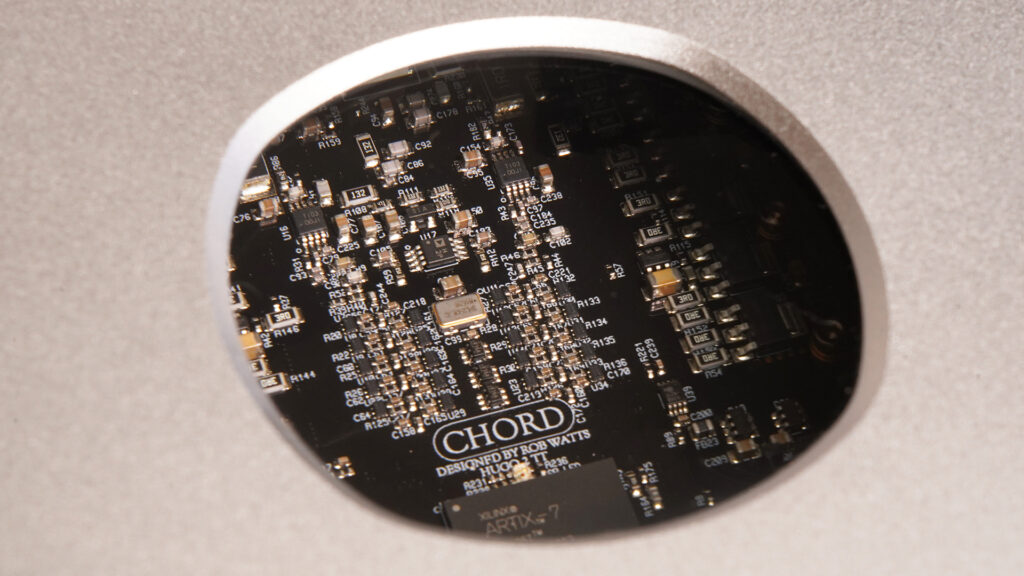
A window into where the magic happens, Chord’s proprietary Xilinx Artix 7 FPGA has got Rob Watts’ name all over it
During playback the TT 2 offers a choice of four digital filters with ‘decisive neutral’ as the default (and billed as tonally the most accurate), followed by ‘decisive neutral with high frequency roll off’ which removes HF noise from 88.2 to 768kHz HD recordings, ‘warm’ then adds a flavour of what it says on the tin and ‘warm with HD roll off’ combines filters two and three.
There’s also a ‘crossfeed’ setting for headphone listening, which blends both stereo channels for a ‘speaker-like’ presentation, with three strength settings from minimal through to broad.
Off the scale
Adding the Hugo M Scaler opens up the door to a much greater suite of sampling choices and performance. Under its hood beats another Rob Watts designed FPGA, this time a Xilinx XC7A200T, with no less than 1,015,808 filter taps.
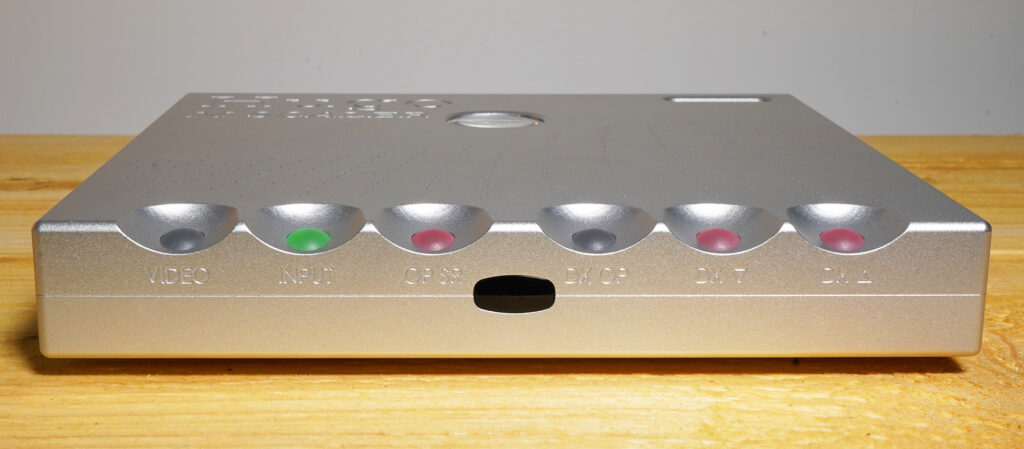
While the M Scaler can be added to any DAC with partnering connections, its dual BNC in/outputs make it an ideal bedfellow for Chord’s own Hugo TT 2, Qutest, Hugo 2 and DAVE DACs
This allows you to upscale traditional ‘Red Book’ standard 44.1kHz sample rates up to 705.6kHz (16x that of CD) while 96kHz audio can be taken all the way up to 768kHz. This means that when hooked up to the TT 2 via (supplied) twin BNC cables, every signal can be improved and delivered at the highest frequency available, rather than relayed on natively, making it a worthwhile upgrade.

M Scaler rear panel offers S/PDIF inputs via BNC and optical (no coaxial RCA) alongside USB, with optical and BNC single/dual outputs
They call him BerTTi
Completing the line up is the BerTTi, a fully balanced 2x75W (8 ohm) Class AB power amp, built around Chord’s ‘ULTIMA’ dual-feed-forward topology.
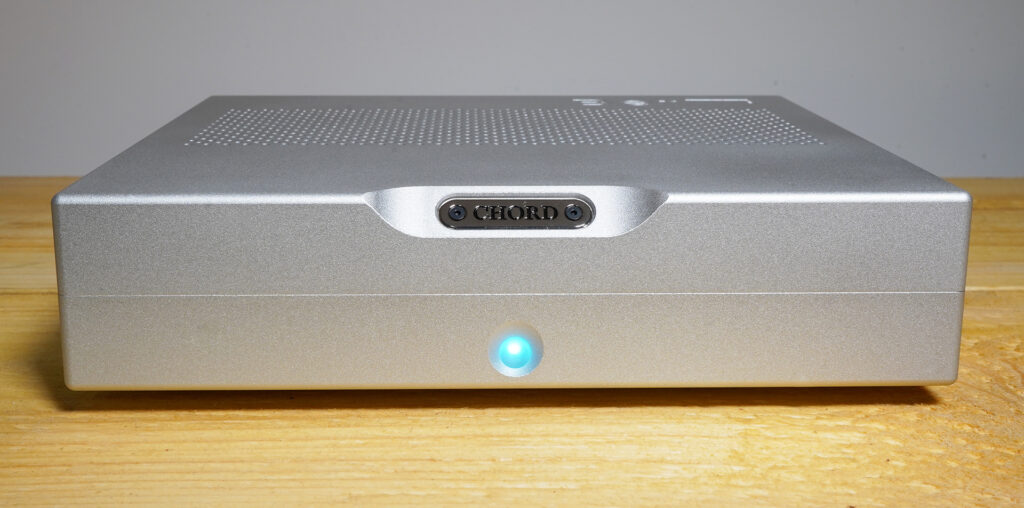
Chord’s unassuming Hugo BerTTi power amp packs a range of the brand’s tech, distilled down from its higher end models
Another proprietary approach, this advanced error-correction tech works by monitoring and immediately correcting signals before the output stage for greater accuracy. Think of it as signal horizon scanning, whereby the power amp prepares for what lies ahead in the signal path, including large dynamic swings.
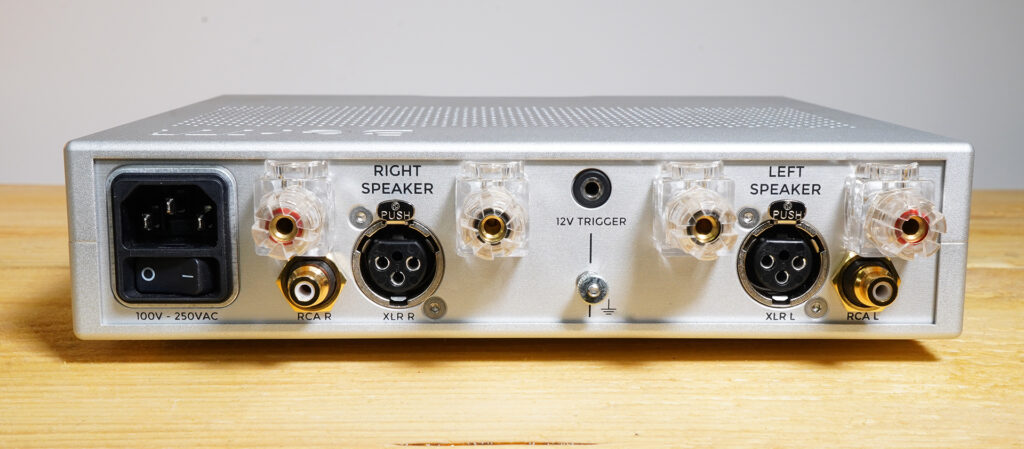
BerTTi’s rear panel is nicely laid out, with clear separation for left and right channels. While balanced and RCA inputs are provided, only one type of connection should be used at any one time during operation
True colours
Starting with the Hugo TT 2 preamp, drawing power from its supplied 15V switch mode PSU to prime its internals takes a few seconds. Once up and running, the first thing to check is that it’s in preamp (rather than DAC) mode, to avoid giving your speakers a nasty full output surprise. And as a simple visual cue, if the central ‘ball’ volume control isn’t backlit (by any colour) then you’re in DAC mode.
The far left front panel switch is the main menu button, accompanied by a select button to its right. Alongside modes, these allow you to toggle through playback and crossfeed filters, plus low and high gain settings and screen brightness for its LED menu within the black curved window that overlaps the front panel.
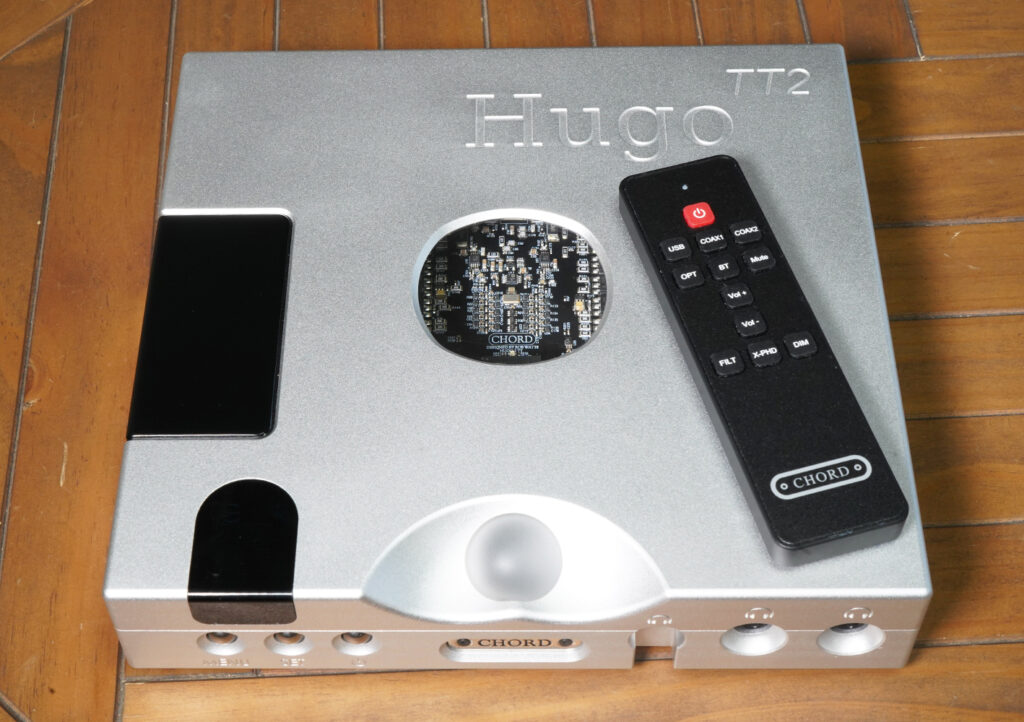
Chord Hugo TT 2’s partnering remote is a functional inclusion (complete with Chord branded batteries – they’ve clearly thought of everything!)
In preamp mode you’re also treated to some colourful visual drama via internal lights within its top panel window and its volume ball glowing red through to lilac (with orange, yellow, green, blue and pink along the way) to denote output level.
The colour-coding continues with the M Scaler, and while this is a fun step away from the usual dull data screens of most audio gear, it takes a little getting used to. Hence keeping the Quick Start one-pager as a reference is essential, until you know what’s what. Its six front panel inset ball lights are also buttons, for selecting input (second from left, with a different colour allocated to each input). And when a signal is received via a chosen input another top panel light (third from left) corresponds to an incoming sample rate, so you can see what you’re getting.
A fourth (fourth from left) ball denotes your chosen upsample rate with options for native (red), medium (green), high (blue) and max (white). While glowing red, the final two globes are as yet redundant, with plans for a further Chord product to get them all lit up further down the line.
Performance
Inputs are via a MacBook Pro laptop running Qobuz and streaming via a Primare NP5 Primsa MkII network player, with its optical output pointing at the Chord gear. Loudspeakers are my go to reference Dynaudio Focus 260 and some soon to be formally reviewed ATC SCM100PSL monitors.
Beginning with just the Hugo TT 2 and BerTTi being fed David Munyon’s 2004 album More Songs For Planet Earth (a benchmark recording at 24-bit/44.1kHz) and the Chord duo immediately challenge their own notion that these are mere table top products. With the Hugo’s digital filter set to ‘decisive neutral’ and crossfeed switched off, what I’m hearing reveals them to be so much more than desktop companions. The clarity with which they present the music is exceptional for a recording at this sample rate, and would put many a hires recording to shame, thanks to how much these amps are able to extract from the audio signal they’re being fed.
While being representative of an ‘everyday’ longstanding reference, my Dynaudios err on the darker side of neutral and require a quality signal to bring our their musicality, thankfully the Chords don’t disappoint. Vocal timbres and the guitar picking for example on Malcomb Wood have just the right blend of firm and soft edges, combined with excellent levels of natural sustain to ensure the performance sounds accurate and convincingly imaged, while not being overly analytical.
Also notable is the soundstage that these combined amps muster, which is as detailed as it is expansive, filling my 4.8 x 6.8m room at moderate levels with rich layers of instrumentation.
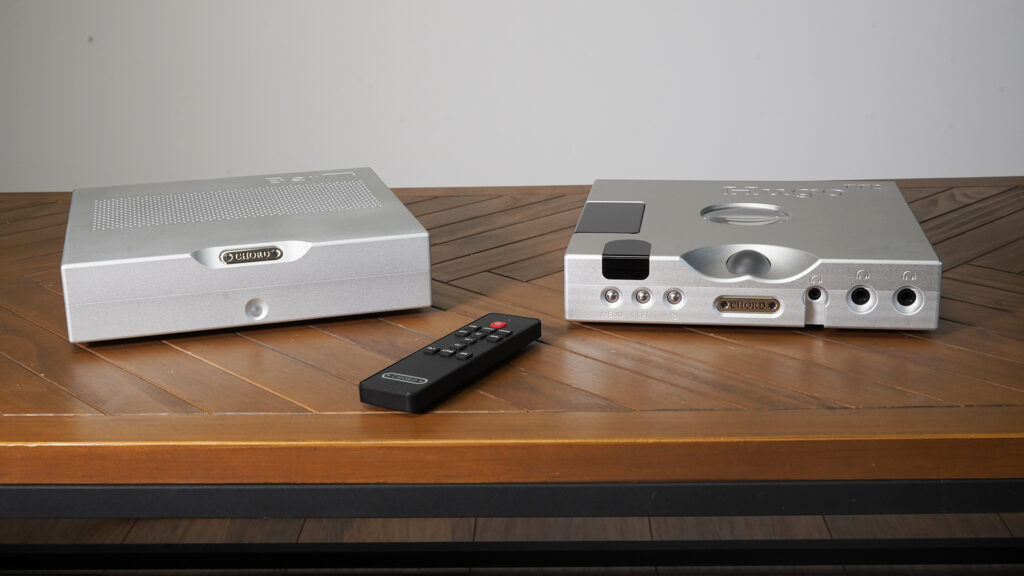
BerTTi and Hugo TT 2 make a convincing amp pairing as an introduction to Chord Electronics’ way of doing things, and you could always add the M Scaler further down the line
Take it to the max
Adding the M Scaler into proceedings via dual BNC connections makes things even more interesting. I generally plumb for native resolution, for a signal that’s closer to what was originally intended, but hearing what the M Scaler is capable of has me reassessing my audio values. Toggling through each oversampling rate on offer all the way up to 705.6kHz brings benefits at every level, which begs the question of why mid level oversampling rates are on offer at all, when most folk will dial it straight to the max to reap the full rewards of the M Scaler.
Hearing Four Wild Horses from the same album and the didgeridoo’s chest rattling reverb is that bit more textured and resonant with each oversampling increase, allowing me to hear not just the fullness of the instrument’s notes , but also get a genuine sense of how its creating them as the air passes through it as a tangible object, as though I can feel as well as hear it vibrate. Or to put it another way, the music simply sounds more real and less forced at every step up. And this added realism continues across the soundstage laid forth by the Chord trio, as notes hang in the air with that bit more finesse to tell you that you’re getting a fully fledged rendition from each recording and not being short changed.
Serving up something a little more complex via Peter Gabriel’s The Court from his i/o album at 24-bit/96kHz (oversampled to 768kHz), and the Chord combination really comes into its own. All the refined smoothness remains as before, but it’s the attack which they bring to the start/stop nature of the percussion that shows how unflappable this combination is. Alongside effortless grip, the pace and energy these amps inject into the music is sit up and take notice levels of arresting, allowing you to enjoy both Gabriel’s musical talent and studio wizardry in equal measures.
So they can do delicacy, they can do pace, and they can do dynamics, but what about scale? Ben Howard’s Nica Libres At Dusk from Noonday Dream (24-bit/44.1kHz native resolution before oversampling) with its swooping melodies soaring deep into the soundstage firmly answers this question, as the weight and scale that’s brought to it by the BerTTi’s modest 75W highlights how each Watt is being used to full effect, challenging the perception that big sounds can only come from large hifi packages.
In Summary
While these amps may be table top in size, they’re more than full-width in sonic stature. As as a stepping stone into Chord Electronics’ way of doing things they are bang on point, with cutting edge internals and styling that bucks the boring trend. The Hugo TT 2 is the obvious place to start as a standalone DAC or preamp with a difference, while adding BerTTi makes perfect sense for a partnership with plenty of dynamics and detail.
And for many this would see them right for years. Just be careful when demoing the M Scaler alongside it, as once you’ve heard what it brings to the table from lesser recordings you’ll not wont want to go back. And on that basis all three come highly recommended.

